
ZAR President Paul Kruger
Back to home Back to Historical
The
Van Rensburg's of Rensburg Siding, Colesberg, Cape part
1
The Anglo-Boer War Introduction
part 2
The Anglo-Boer War around
Rensburg Siding: Boer Leaders part 3
The Anglo-Boer War around Rensburg Siding Nov 1899 part
4
The
Anglo-Boer War around Rensburg Siding Dec 1899 part
5
The
Anglo-Boer War around Rensburg Siding Jan 1900 part
6
The Anglo-Boer War around
Rensburg Siding Feb 1900 part 7
The
Anglo-Boer War in retrospect part
8
Australian units, persons and casualties part
9
MAIN
MAP source http://www.mjvn.co.za/anglo-boer/mainmap1.jpg
The Anglo-Boer War: Australians capture De Wet's artillery gun at Rensburgdrift part 10
Page 1 Page 2
The
Anglo-Boer War around Rensburg Siding
November - 1899
The British were an imperialistic superpower very interested in the gold and diamonds that were discovered in the Boer Republics. The two Republics also stood in the way of the English who planned to paint the African map red from Cape Town right up to Cairo. To bring this about the existence of independent free nation states as the Zuid-Afrikaansche Republiek (ZAR) and the Orange Free State (OFS)could no longer be tolerated.

ZAR President Paul Kruger
The British military machine had been built on the Roman principle of discipline and a numerically large number of fighting forces. However, the British relied to a far greater extend on their infantry. This was put into practice by an united defense system, an united attack strategy, and the use of a circular or square formation for defensive purposes. The fighting soldiers formed one long dual firing line which enabled them to fire in synchronism. The first line fireing first, and then the second row stepping forward for the next round or volley. More or less the same method of attack were used when a battery of artillery guns fired its shells in a preset sequence. The Boers strategy and plans were far more adaptable to the circumstances, later in the war the English were far less rigid in their approach.
.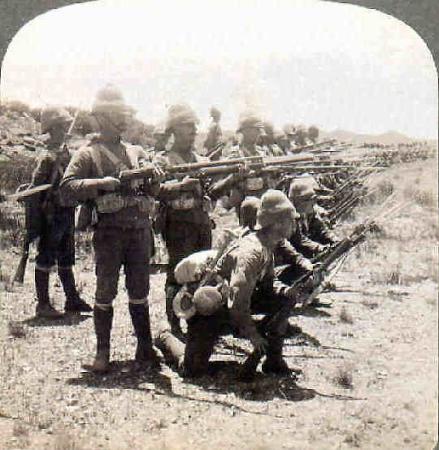
Soldiers of Colonel Porter with bayonets ready practicing to meet a Boer Cavalry
charge,
Naauwpoort 13 December 1900
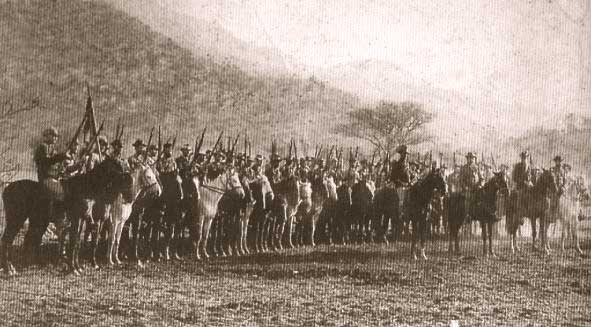
A Boer commando from Pretoria, October 1899
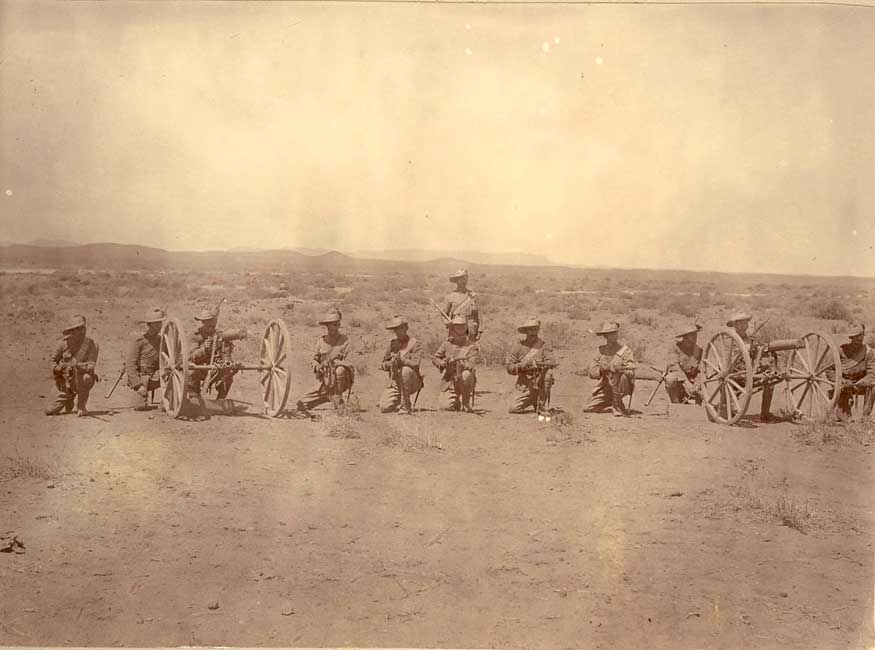
British soldiers, note the slouch hats, they may very well be Australians
Photo provided by Alwyn P. Smit
Making use of guerilla warfare and camouflage was relatively a neglected, even unknown to a certain extent, art of war by the British. This was a lesson they learned the hard way. The Boers were a citizen force called upon to defend their families and country. They were not professional soldiers with uniforms (apart from the Staats Artillerie and ZARP). They wore ordinary clothes and suites and even wore ties while defending their beloved land. The English expected a conventional war with a head-on clash with the enemy, but in fighting the Boers they were confronted with an enemy without uniforms. The Boers, though greatly outnumbered, were masters at disguise, hiding and retreating. In fact, the British were caught unawares by this new form of warfare namely guerilla attacks. The Boers had experience in their conflicts with African tribes, a small minority facing a foe that numerically outnumbered them.
As far as we are aware the Boers did not make use of trenches in the regions in and around Colesberg. However, wherever they dug trenches, they would be disguised or camouflaged. "The Boers were the first to demonstrate the advantage of camouflaging field works ... The Boers were hunters who used rifles and waiting tactics in the same style as hunting prey. Their skills easily translated into trench warfare in their conflict with the British." quoted from Masters thesis of Richard H. Hephner, Where Youth and Laughter Go: The experience of trench Warfare from Petersburg to the Western Front, p. 13, Virginia Polytechnic Institute and State University, 1997.
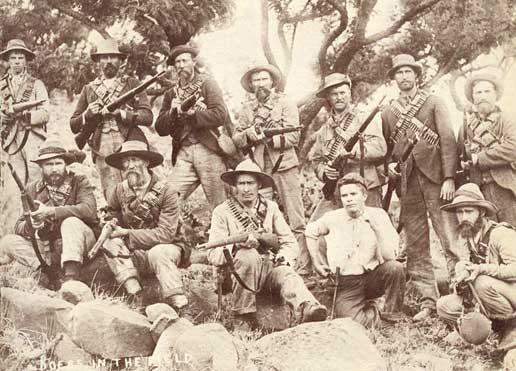
A group of Boers well adapted to the country fighting in their civilian
clothes
On occasions they would place the trenches not in the kopjes (hills) but to the front of the kopje and remain hidden while the bombs went flying over their heads. The unexpected British soldiers who would come to mop up were caught in the open veldt facing the fire of the Boers who were protected in their trenches. The English were disgusted by the Boers way of warfare and considered the Boers strategy to fall outside the concept of fair-play. More often than not the Boers made full use of natural kopjes for protection. On the other hand the English concept of warfare included retreat, but they would not hide - at least not as well as the Boers who knew the veldt since childhood. The Boers always had a route of escape, retreating to another nearby kopje. They had a saying "Vlugt met Moed", meaning flee with courage. For the Boers when things got out of hand and one was overwhelmed by the enemy numbers, it was in order to flee and return to return to fight another day. As already mentioned, the Boers made use of surprise attacks. The English were thus confronted with a well-hidden enemy firing on them, but many a time they were not able to even see the enemy themselves. Not to be forgotten, the Mauser rifles which the Boers used were in many ways superior to the English Lee Enfield. In addition to this the Anglo-Boer War also saw the introduction of smokeless gunpowder which made detection even more difficult.
The Boers had the best training ground to be top marksmen, hunting African game were part of their lifestyle. With limited ammunition they also had to learn to shoot, with every bulletin being relied upon.
The Boers were nearly all cavalry and this enabled them to cover vast terrain very quickly. The mobility of the Boers, relying on their horses was one of the ways that a minority was able to face a superior enemy. As the war unfolded the lack of horse feed and lack of horses or tired horses greatly hampered the Boers. Whereas the English included large numbers of infantry suffering under the scorching hot Karoo sun. The Boers looked at the red sun burnt skins of the milk-white European soldiers, and jokingly gave them the name "Rooinek" - literally meaning Red necks). Infantry are often restrained by logistics since they have to remain close to where they could receive supplies, food and much needed water.

A group of Boers preparing for war, note the way they are dressed
Photo supplied by Alwyn P Smit
Taking the above-mentioned facts into consideration, it is therefore no wonder the Australians and New Zealanders were far more adapt to fight in the Anglo-Boer War. Many Australians, like the Boers, were from a farming background and they had a far greater independent spirit than the English Tommy (as the Boers also called them). The Australians also came from a hot barren country with great distances, like South Africa. The Boers on the other hand were such free and independent individuals, that it eventually led to their downfall. They would often have quarrels amongst themselves and at times would refuse to obey orders from their superiors. To their detriment the English relied on the orders being given by the officers. Once their officers were killed, the command structure inevitable fell in disarray. The Boers also targeted these officers in the battle since they stood out in their distinctive uniforms. The English later realized this and changed their officers uniforms to make them less of a target.
The Boers immediately exploited these circumstances and could thereby make full use of their local knowledge of the lay of the land. The English however, only had very small maps with very little useful topographic information. Reconnaissance was mainly to determine where the Boers were, rather than obtaining a full knowledge of the terrain. This manifested one of the big weaknesses of the English, their lack of intelligence gathering. As the war progressed the English made use of "tame Boers", a term used by the English for those Boers who turned against their own kin, to obtain intelligence. Nevertheless, the English had to cope with assembling and supplying the largest army since the days of Napoleon, and this was no small logistic feat. Though the Boers were in the end defeated during the Anglo-Boer War, this war inevitably and undeniably paved the way for the beginning of the end of the British Empire.
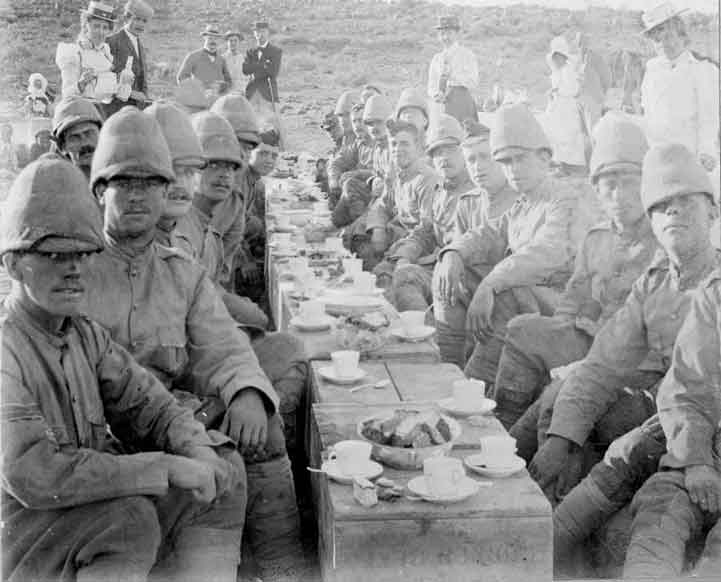
The disciplined
English khaki army sitting in a neat row enjoying biscuits and tea,
most probably provided by British subjects and/or sympathizers from a nearby
town
Photo provided by Alwyn P Smit
The Boer forces at Rensburg Siding / Colesberg
The ZAR
Commandos:
Germiston Commando
Johannesburg Commando
Krugersdorp Commando
The OFS Commandos:
Bethlehem Commando
Heilbron Commando
Kroonstad Commando
ZARP (Zuid-Afrikaansche Republiek Politie):
Foreign
Corps:
German Corps. Lieutenant
Von Aldebyll
The English
forces at Rensburg Siding / Colesberg
2nd Bedfordshire Regiment Jan. 1900
2nd Royal Berkshire Regiment
6th (Inniskilling) Dragoons Nov. 1899
6th Dragoon Guards (Carabiniers) Nov.1899
1st Essex Regiment December 1899
10th (Prince of Wales's Own) Hussars Nov.1899
1st Royal Irish Regiment Jan. 1900
1st Life Guards Dec. 1899
Royal Horse Guards Dec.1899
1st Suffolk Regiment Nov. 1899
1st Welsh Regiment Nov. 1899
2nd Wiltshire Regiment (Duke of Edinburgh's) Jan. 1900
2nd Worcestershire Regiment Jan. 1900
1st Yorkshire Regiment Dec 1899
The Australian
Regiment constituted the following companiess:
1 Company Mounted Rifles, Victoria
1 Company Infantry, Victoria
1 Company Infantry, South Australia
1 Company Infantry, Western Australia
1 Company Infantry, Tasmania
1 Company Infantry, NSW
Plus a New Zealand contingent
Rensburg Siding and Colesberg are surrounded with very rocky kopjes, which are ideal natural fortresses. The kopjes stand amidst the flat Karoo veldt. The Boers held a position north of Colesberg and stretching south-east to Rensburg Siding. The two forces fought for the possession of many kopjes but also for the control of Arundel and Rensburg Siding which served as head-quarters for the English and Boers.